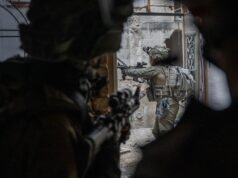The United States maintains a military force primarily to protect the homeland from attack and to protect its interests abroad. There are secondary uses, such as assisting civil authorities in times of disaster, deterring opponents from threatening America’s interests, bolstering alliances, and underwriting diplomatic and economic initiatives. But the force’s primary purpose is to make it possible for the U.S. to physically impose its will on an enemy when necessary. To maintain a force for this purpose, the U.S. spends a great deal of money. The defense authorization for FY 2016, passed by the Congress and signed into law by President Obama, totals $607 billion, approaching $100 billion above the baseline level allowed by the Budget Control Act of 2011. Clearly, the White House and Congress concur with the military service chiefs that the demands of securing U.S. security interests outweigh partisan debate over the growing size of the national debt.
The most vital of these national security interests include:
- Defense of the homeland;
- Conclusion of a major war that has the potential to destabilize a region of critical interest to the U.S. in a way that favors that interest; and
- Preservation of freedom of movement within the seas, air spaces, outer-space, and even cyberspace through which the world conducts its business.
To defend these interests effectively on a global scale against challenges from a diverse set of competitors, the United States needs a military force of sufficient size, that possesses relevant capabilities, and that is ready for action—materially and competently; all of which cost money.
The question of how much to spend on defense capabilities is debated every year leading one to wonder why this is such a difficult question.
If one could predict where forces will be needed and for what type of conflict, defense planning would be easier, but this is impossible to do with absolute certainty. Still, reasonable forecasts can be made, informed by experience and analysis. History tells us quite a bit about the actual use of military force by the United States and a number of top-level studies on national defense requirements have been undertaken over the past quarter-century to include the Bottom-Up Review of 1992 and the Congressionally-mandated Quadrennial Defense Review (QDR) and National Defense Panel (NDP) reports.
From the Korean War onward, the United States has found itself in a major war every fifteen to twenty years, and in each instance used roughly the same size force. Further, each of the nine major studies came to roughly the same recommendations for end strength, major platforms, and large unit formations. Consequently, this provides a fairly reasonable basis upon which to estimate the amount of force the U.S. should have at-the-ready and, accounting for fluctuations in the cost of labor and key technologies relative to competitor investments and capabilities, corresponding investments to maintain it.
Numbers Matter
The U.S. should maintain an active Army of 50 brigade combat teams (BCTs), a Navy approaching 350 ships, an Air Force of at least 1,200 fighter/attack aircraft, and a Marine Corps based on 36 battalions. This size force would provide the U.S. the ability to fight a major war or handle a major sustained contingency [e.g. Korea, Vietnam, Gulf War (1991), and the Iraq War (2003-2011)] while also having sufficient capacity to sustain large-scale commitments elsewhere [e.g. U.S. presence in Europe and across the world’s oceans during the Cold War (1947-1991)] or respond to an emergent crisis should a major competitor try to take advantage of a perceived “window of opportunity” (one could argue this is what has occurred with Russia in Ukraine and China in the South China Sea). In other words, this force enables the country to handle one major crisis and deter competitors from acting opportunistically.
There are also practical realities in the use of force that should inform thinking about “how much?” The nature of war and the operating spaces within which it is waged require large forces to control territory or to deny such to an enemy force. Conventional combat operations require sizable forces to replace combat losses and to rotate fresh units into battle. Sustained security operations require a large rotational base to maintain a given level of force in place over many years. Small numbers of exquisitely equipped forces are inadequate to such situations and can lead to a force that is overly sensitive to combat losses or is quickly worn down by numerous deployments in rapid succession.
Numbers also matter in preparing for the future. When the force is small and is already hard-pressed to meet current operational demands, little capacity is available to do the things necessary to ensure the U.S. will be able to prevail against future threats and to protect its interests in future settings the details of which one cannot know beforehand. If new ways are needed to maintain a competitive advantage over opponents, then a portion of the force must be available for experimentation whether by reducing current demands on the force or enlarging it so that it can do all the things being demanded of it.
It is plain to see that capacity—i.e. having a sufficiently large force—is an enduring, critical reality of conflict and securing U.S. interests. This should drive discussion about defense spending. And yet, spending on the military has been in decline the past several years to ruinous effect. Consider the following:
The U.S. Army has continued to reduce its end strength and accept greater risk to its modernization programs to preserve what readiness it can. The reduction in end strength since 2012 has had a disproportionate effect on the number of BCTs the Army maintains. The Active Army shrank from 552,100 soldiers and 45 BCTs in FY 2013 to 490,000 soldiers and 32 BCTs in FY 2015. Thus, a 12 percent reduction in troop numbers resulted in a 29 percent reduction in BCTs. Worse, the Army is scheduled to shrink further to 450,000 soldiers by the end of 2016. General Raymond T. Odierno, former Chief of Staff of the Army, has stated that the Army can maintain only one-third of its force at acceptable levels of readiness.
The U.S. Navy’s mandate is “To be where it matters, when it matters.” To this I would add “with sufficient capacity to matter.” The Navy enables the United States to project military power in the maritime and air domains, and its peacetime forward presence supports missions that include securing sea lines of communication (SLOC) for the free flow of goods and services, assuring U.S. allies and friends, deterring adversaries, and providing a timely response to crises short of war. But the Navy is too small to continue doing this on a sustained basis and is woefully postured to conduct sustained combat operations against a major opponent. Current levels of funding make it unlikely its status will improve anytime soon and will most likely deteriorate further. The Navy’s current goal is 308 ships but the Congressional Budget Office (CBO) has calculated that it needs $20.7 billion annually for ship building to reach just 306 ships while it is only being funded at $16.6 billion for FY 2016.
The U.S. Air Force provides military dominance in the domains of air and space. Unfortunately, the USAF is now the oldest and smallest in its history, and the problem is worsening as the demand for air power grows. Currently, the Air Force’s fleet of fighter/attack aircraft has consumed approximately 80 percent of its planned service life with replacement aircraft greatly delayed and at much higher costs than planned. The FY 2016 Air Force Posture Statement acknowledged that continued cuts in capacity will result in a loss of capability: “[W]e have reached a point where the two are inextricable; lose any more capacity, and the capability will cease to exist.”
While the fighting competence of the U.S. Marine Corps is superb, it is hampered by aging equipment, troubled replacement programs for its key ground vehicles (particularly its amphibious personnel carriers), and a shrinking force. Overall reductions in end strength have left the USMC with 23 infantry battalions in the Active Component, down from 25 in 2014 and 27 in 2013. Under full sequestration, USMC end strength would be able to support only 21 infantry battalions, which, according to former Commandant of the Marine Corps General Dunford, would leave the USMC “with fewer active duty battalions and squadrons than would be required for a single major contingency.”
Strategic Forces
And if the above status of America’s conventional forces wasn’t bad enough, America’s ability to deter strategic threats with its inventory of nuclear weapons is also in jeopardy. While the United States’ ability to deliver a nuclear weapon to a target is currently sound, all of the things necessary to ensure this capability remains viable are in decline. The complex that comprises the key elements of America’s strategic nuclear power includes warheads, delivery systems, nuclear command and control, the physical infrastructure that designs, manufactures, tests, and maintains U.S. nuclear weapons, and the talent of people from physicists to chemical engineers to maintainers and operators.
Delivery platforms are good, but the force depends on a very limited set of weapons (in number of designs) and models that are quite old, in stark contrast to the aggressive programs of other nuclear states like Russia, China, Pakistan, North Korea, and nuclear-aspirational Iran. Absent nuclear weapons testing, the assessment of weapons reliability becomes quite subjective. Testing was originally used to diagnose potential problems and to certify the effectiveness of fixes to those problems, not to forecast future viability. Modern simulation is based on nuclear tests that were conducted primarily in the 1950s and 1960s, using testing equipment of that era. Renewed testing is needed but it will cost money that hasn’t even been considered in current budget deliberations. To be sure, the Department of Energy is planning to invest $100 billion over the next ten years to modernize nuclear facilities and weapons components but renewed testing is still off the table.
Though modern technologies provide U.S. forces clear advantages in many areas, especially against similarly equipped opponents, they are usually expensive and can come at a cost in capacity. Similarly, the contributions of allies and partners can augment U.S. operations but are always limited by their own domestic political interests and cannot be relied upon as a de facto component of U.S. national security policy.
How Much Should we Spend?
Threats today include Russia, China, Iran, North Korea, and the aggregate challenges to order and stability in key regions posed by Middle East and Afghanistan/Pakistan-based terrorist groups. None of these threats were considered worrisome just a few years ago yet today they dominate news headlines, a reminder of the earlier point that one cannot predict future challenges. However, one can be prepared by maintaining military strength in modern forces with sufficient capacity to handle challenges as they arise. Yet, in spite of ample evidence that warns against weakening America, the substantial cuts in defense funding since 2012 have resulted in a steadily shrinking, aging, and less ready force at a time when threats are growing more numerous, aggressive, and capable.
Once again the question becomes, “How much should be spent on the U.S. defense portfolio?”
Since World War II, spending on the military has averaged approximately 5.2 percent of America’s gross domestic product (GDP). With an economy currently valued at roughly $18 trillion and growing, albeit modestly, 5.2 percent would equate to a defense budget of $936 billion. Does America need to spend that much on its military? Likely not, but history does show that it is within the country’s ability to do so and, in past times, national security was sufficiently important enough to warrant such spending.
As we have seen, a baseline budget of $500 billion, or 2.8 percent of GDP, as limited by the Budget Control Act of 2011, has led to a shrinking, aging, and less ready force ill-postured to deal with the growing array of diverse threats to U.S. interests. Recognition of this led to the aforementioned budget agreement for FY 2016 of $607 billion (3.37 percent of GDP). By all accounts, this level of funding will help to keep the force from declining below levels already planned, i.e. the reduced Army, Navy, Air Force, and Marine Corps mentioned, but will do very little to rebuild the military to the levels necessary to adequately meet national security requirements.
So, the answer to “how much?” seems to be somewhere between the too-little level of today’s budget—$607 billion or 3.4% of GDP—and the historical average of 5.2 percent which would be $936 billion with today’s economy. At 4 percent of GDP, the budget would equal $720 billion; 4.5 percent would mean $810 billion; while a 5 percent reference point would yield $900 billion.
And What Will it Buy?
For a reasonable estimate of what is likely needed, consider some major programs and average costs to keep the services at higher levels of size and readiness:
- The Air Force is acquiring a new bomber, the Long Range Strike Bomber, estimated at $400 billion over a ten year period.
- The Navy must replace its Ohio-class ballistic missile submarine; $140 billion over twenty years.
- The Air Force is planning to replace its Minuteman ICBMs at $60 billion over ten years and introduce a new nuclear-capable air-launched cruise missile (ALCM) at roughly $25 billion over the same time period.
- The Army and Navy each need an increase of $10 billion per year to rebuild their brigades and increase their shipbuilding capacity, respectively, while the Marines need a boost of at least $5 billion per year to expand their end strength and acquire needed replacements for aged ground equipment.
This amounts to $100 billion in additional spending per year above the currently planned $607 billion (for FY 2016) or a revised baseline of roughly $700 billion, just under four percent of GDP and well within the historical norm for the U.S.
Is this too much? Well, it is clear that current spending has been disastrous for the U.S. military so more is certainly needed. Is it enough to defend U.S. national security interests? Again, history shows that the U.S. needs sufficient capacity to defend its interests in multiple places at the same time and, today, increasingly against a diverse array of challengers. With this in mind, an annual defense budget of $700 billion seems both historically valid and currently needed.
By any accounting, this is a great deal of money but in considering whether it is not only reasonable but also necessary, perhaps another question should be asked: “Is the current trend in defense spending good for America’s security interests?” Judging by reports from the military service chiefs on the condition of their respective services and the proliferating challenges to U.S. interests in Asia, the Middle East, Europe, Africa, and even in Central/South America, the answer is a resounding “no.” Consequently, if Americans want their security interests better served at home and abroad, they and their elected representatives need to decide where spending on defense ranks in priority relative to all other government spending.
Dakota L. Wood is a Senior Research Fellow, Defense Programs, at The Heritage Foundation.





